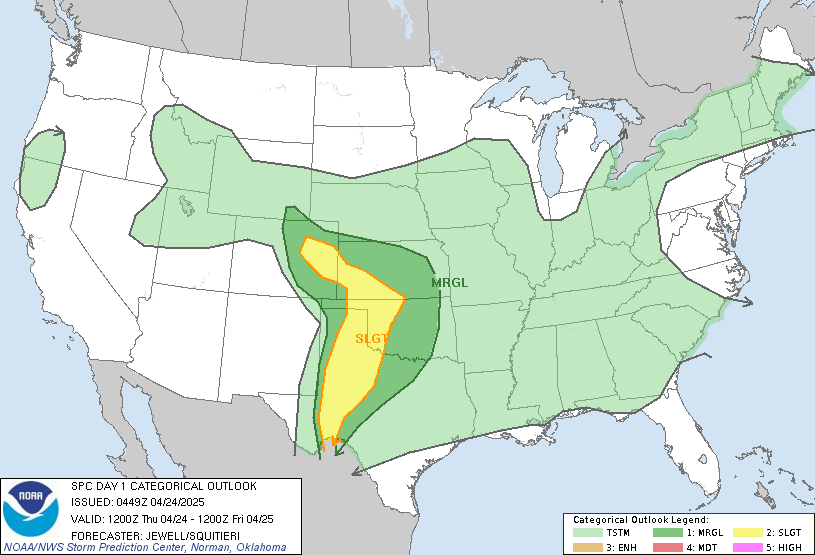LIVE MAP (ABOVE) ... SPC 1200Z Day 1 Outlook
Day 1 Convective Outlook
NWS Storm Prediction Center Norman OK
0101 AM CDT Tue Jul 18 2023
Valid 181200Z - 191200Z
...THERE IS A SLIGHT RISK OF SEVERE THUNDERSTORMS ACROSS PORTIONS OF
THE MID-MISSOURI VALLEY INTO THE LOWER OHIO VALLEY AND THE
DAKOTAS....
...SUMMARY...
Thunderstorms associated with large hail and damaging wind gusts
will be possible this morning/afternoon through Missouri and again
overnight across parts of the mid Mississippi/Lower-Missouri Valley.
Other strong to severe storms will also be possible in various parts
of the US from the Great Basin and Southwest and from the Plains to
the Midwest and East Coast.
...Synopsis...
A mid-level ridge across the western CONUS will flatten this morning
as a trough crosses Montana. Another somewhat convectively enhanced
mid-level shortwave trough across the central Plains this morning
will move southeast into the Tennessee Valley tonight. A broad
mid-level trough across the Great Lakes into the Northeast will
shift slowly east through the day. The surface pattern is more
nebulous with a diffuse surface front extending from the Northeast
across the southern Great Lakes and into the Plains. Across the
Plains, a warm front will become better defined as a surface low
develops across Kansas. An additional cold front, currently across
eastern Montana, will move east across the northern Plains and
become more defined through the day.
...Lower Missouri Valley to the Lower Ohio Valley...
Current convective trends and surface analysis suggests a line of
elevated storms across central Nebraska currently will likely
intensify as it moves into greater instability across southeast
Nebraska/northeast Kansas. Several members of the 00Z HREF support
this evolution with several showing the potential for a
well-developed bow echo moving across Missouri this morning and
potentially through the afternoon into the Mid-Mississippi/Tennessee
Valley region. Even if a mature bow echo can develop, the longevity
may remain questionable due to downstream destabilization as a large
cloud mass could inhibit heating downstream and perhaps limit the
threat for a more significant severe wind threat.
Late tonight and into Wednesday morning, elevated thunderstorms are
expected to develop along a northwest-southeast oriented frontal
zone in the vicinity of southeast Missouri. The location of this
convection remains uncertain as the location of the frontal zone
will augmented by the intensity/location of convection from the
thunderstorms this morning. Nonetheless, wherever this boundary
aligns, supercells will pose a threat for large hail given strong
elevated instability and strong deep layer shear. Eventually, some
upscale growth will be possible and a severe wind threat may develop
across the Mid-Mississippi Valley closer to 12Z Wednesday.
...Northern Plains...
A combination of low-level moisture advection and surface heating
will lead to moderate to strong instability across central North
Dakota and South Dakota by this afternoon. This instability,
combined with convergence from a sharpening cold front and an
approaching mid-level shortwave trough should be sufficient for
storm development along the cold front this afternoon. 45 to 55
knots of mid-level flow will result in supercell wind profiles and a
threat for large hail, some potentially 2+ inches.
...Mid-Atlantic to the Northeast...
Weak, broad ascent across an uncapped and moderately unstable warm
sector across the Mid-Atlantic and Northeast may result in isolated
to widely scattered thunderstorms. Some stronger flow, particularly
from New York northeastward will promote more storm organization and
the potential for rotating updrafts. These longer-lived updrafts may
pose some threat for isolated large hail and damaging wind gusts.
...Central High Plains...
A few thunderstorms are possible late this afternoon as low-level
flow veers from northeasterly to easterly and becomes more upslope
with low-level moisture advection on the northern periphery of the
surface cyclone. The favorable period may be relatively short-lived
since moisture arrives late, but a favorable environment may develop
with 2000+ J/kg MLCAPE and a supercell wind profile.
...Great Basin...
A deeply mixed airmass is expected today across the Great Basin with
ample instability for scattered thunderstorms across much of the
region. A belt of stronger mid-level flow around 30 knots will exist
from east-central Nevada and across north-central Utah. This may
support some storm organization with the potential for isolated
severe wind gusts given the deeply mixed sub-cloud layer.
...Southern Arizona...
Weak to moderate instability is expected to develop across southeast
Arizona today with a LCL around 3000m. Shear will be weak in the
region with less than 10 knots of flow through the troposphere,
which will limit storm organization. However, this instability,
coupled with sub-cloud evaporative cooling in the well mixed airmass
may support some strong to severe wind gusts this afternoon/evening.
..Bentley/Wendt.. 07/18/2023
Read more CHECK UPDATE ZOOM GRAPHIC
http://dlvr.it/SsLWYX
Windy.com Temps | Gusts | WU KORD KPWK |
CLICK for this month's BIG night sky ... | RADAR FULL MAP SCREEN |
|---|
MOBILE DEVICE? Turn sideways. Weather conditions directly above are near Lakefront. Top tabs refer to O'Hare (official).
Archives for the SPC Convective Outlook are updated daily (approximately) with a live map at the beginning of each article. Follow the link at the end of the article to check for current updates on the NOAA/NWS Storm Prediction Center website. Also, see Archives for Chicago's hourly weather data on CARDINAL NEWS Magazine.
CONVECTIVE | TORNADO | WIND | HAIL
O'Hare International Airport KORD
(Arlington Heights South)
Chicago Executive Airport KPWK
(Arlington Heights North)
Tuesday, July 18, 2023
SPC Jul 18, 2023 0600 UTC Day 1 Convective Outlook
SUNRISE AND SUNSET TIMES IN UTC (if you're not logged in to Google)
CHICAGO UTC-6 during CST (Central Standard Time, e.g., winter)
CHICAGO UTC-5 during CDT (Daylight Savings Time, e.g., summer)
CHICAGO UTC-6 during CST (Central Standard Time, e.g., winter)
CHICAGO UTC-5 during CDT (Daylight Savings Time, e.g., summer)





















